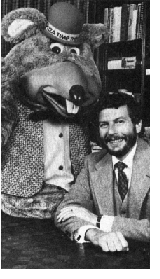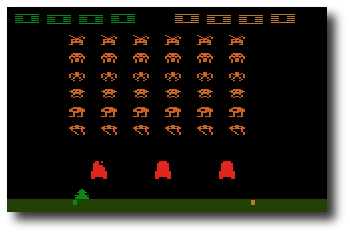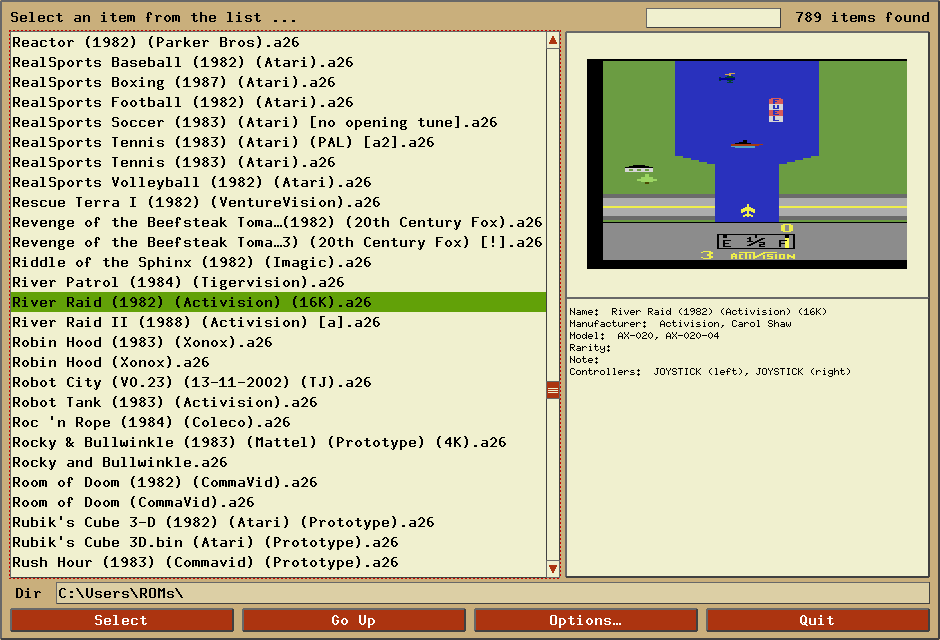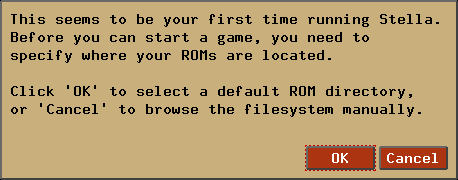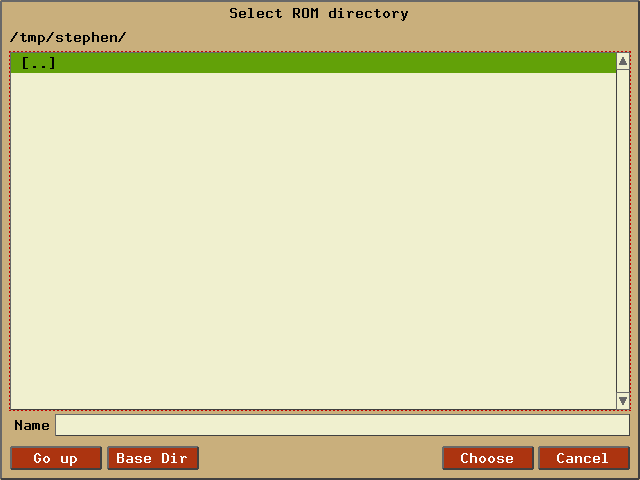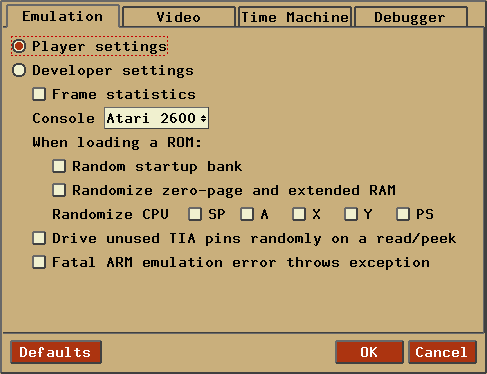The browser should be self-explanatory. The 'Go Up' button moves to the parent
folder (if it exists), and the 'Base Dir' button moves to the base directory where,
by default, all Stella-related files are stored. Double-clicking an item will
enter that directory. Click 'Choose' to select the location, or 'Cancel' to exit
the browser. Note that if you don't select a ROM directory now, you will be prompted
again the next time Stella is started.
At this point, you may want to set the locations for snapshots and other
external paths. This is described in more detail in
Advanced Configuration - Snapshot Settings and
Advanced Configuration - Config Paths.
These settings are optional, and can be left at the defaults if you won't be using
snapshots in the ROM launcher.
Once you've correctly set the default ROM directory, you can start emulation by
selecting a ROM and pressing 'Enter' or clicking 'Select', or double-clicking a ROM.
Note that some games require you to 'Reset' the console before you start playing. In this
case, you need to hit the virtual reset switch, which by default is the F2 key.
Also, some games may require that you press the joystick fire button to begin,
which by default is the Left Control or Space key(s). If a game uses a
more complex controller, see
Getting Started - Keyboard Layout
for more information. To exit a game and re-enter the ROM launcher, press the 'Escape'
key.
Using the 'Search' textbox in the upper-right of the ROM launcher, the
listing can be narrowed down, showing only the ROMs that match the pattern
you enter.
Command Menu
While playing a game, normally one would use the keyboard shortcuts for controlling the
'virtual' switches in Stella (ie, the commands associated with the
function keys as described in
Getting Started - Keyboard Layout).
However, another alternative is available. Pressing the '\' key toggles
a command menu dialog as follows:
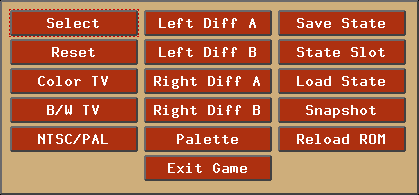
This dialog contains a set of buttons that represent the same functionality
as the function keys. You may find this useful if you cannot remember all
the function key events, or you wish to use Stella without a keyboard (ie,
in a standalone gaming system).
The Atari 2600 console controls and controllers are mapped to the computer's
keyboard as shown in the following tables. However, most of these events can be
remapped to other keys on your keyboard or buttons on your joystick (see
Advanced Configuration - Event Remapping).
The tables below show the default settings.
Note: All key names are based on the US QWERTY
keyboard layout.. If you use a different layout some keys may differ. You can use the
following layout image as reference where to find the US keys on your keyboard.

Console Controls (can be remapped)
| Function |
Key (Standard) |
Key (MacOSX) |
| Exit emulator |
Control + q |
Cmd + q |
| Exit game mode/enter launcher mode |
Escape |
Escape |
| Enter/exit options mode |
Tab |
Tab |
| Enter/exit command mode |
Backslash (\) |
Backslash (\) |
| Enter/exit debugger |
Backquote (`) |
Backquote (`) |
| Select Game |
F1 |
F1 |
| Reset Game |
F2 |
F2 |
| Color TV |
F3 |
F3 |
| Black/White TV |
F4 |
F4 |
| Left Player Difficulty A |
F5 |
F5 |
| Left Player Difficulty B |
F6 |
F6 |
| Right Player Difficulty A |
F7 |
F7 |
| Right Player Difficulty B |
F8 |
F8 |
| Save state to current slot |
F9 |
F9 |
| Change current state slot |
F10 |
F10 |
| Load state from current slot |
F11 |
F11 |
| Save PNG snapshot |
F12 |
F12 |
| Pause/resume emulation |
Pause |
|
Joystick/BoosterGrip Controller (can be remapped)
| Left Joystick (Joy0) |
Right Joystick (Joy1) |
| Function |
Key |
| Joystick Up |
Up arrow |
| Joystick Down |
Down arrow |
| Joystick Left |
Left arrow |
| Joystick Right |
Right arrow |
| Fire Button |
Space |
| Trigger Button |
4 |
| Booster Button |
5 |
|
| Function |
Key |
| Joystick Up |
Y |
| Joystick Down |
H |
| Joystick Left |
G |
| Joystick Right |
J |
| Fire Button |
F |
| Trigger Button |
6 |
| Booster Button |
7 |
|
Paddle Controller digital emulation (can be remapped independently of joystick controller)
| Left Paddles |
Right Paddles |
| Function |
Key |
| Paddle 0 decrease |
Same as 'Joy0 Left' |
| Paddle 0 increase |
Same as 'Joy0 Right' |
| Paddle 0 Fire |
Same as 'Joy0 Fire' |
| Paddle 1 decrease |
Same as 'Joy0 Up' |
| Paddle 1 increase |
Same as 'Joy0 Down' |
| Paddle 1 Fire |
Same as 'Joy0 Booster' |
|
| Function |
Key |
| Paddle 2 decrease |
Same as 'Joy1 Left' |
| Paddle 2 increase |
Same as 'Joy1 Right' |
| Paddle 2 Fire |
Same as 'Joy1 Fire' |
| Paddle 3 decrease |
Same as 'Joy1 Up' |
| Paddle 3 increase |
Same as 'Joy1 Down' |
| Paddle 3 Fire |
Same as 'Joy1 Booster' |
|
Driving Controller (cannot be remapped, always associated with joystick controller)
| Left Driving |
Right Driving |
| Function |
Key |
| Left Direction |
Same as 'Joy0 Left' |
| Right Direction |
Same as 'Joy0 Right' |
| Fire Button |
Same as 'Joy0 Fire' |
|
| Function |
Key |
| Left Direction |
Same as 'Joy1 Left' |
| Right Direction |
Same as 'Joy1 Right' |
| Fire Button |
Same as 'Joy1 Fire' |
|
Sega Genesis Controller (cannot be remapped, always associated with joystick and booster-grip controllers)
| Left Pad |
Right Pad |
| Function |
Key |
| Pad Up |
Same as 'Joy0 Up' |
| Pad Down |
Same as 'Joy0 Down' |
| Pad Left |
Same as 'Joy0 Left' |
| Pad Right |
Same as 'Joy0 Right' |
| Button 'B' |
Same as 'Joy0 Fire' |
| Button 'C' |
Same as 'Joy0 Booster' |
|
| Function |
Key |
| Pad Up |
Same as 'Joy1 Up' |
| Pad Down |
Same as 'Joy1 Down' |
| Pad Left |
Same as 'Joy1 Left' |
| Pad Right |
Same as 'Joy1 Right' |
| Button 'B' |
Same as 'Joy1 Fire' |
| Button 'C' |
Same as 'Joy1 Booster' |
|
Keypad Controller (can be remapped)
| Left Keypad |
Right Keypad |
| Pad Button |
Key |
| 1 |
1 |
| 2 |
2 |
| 3 |
3 |
| 4 |
Q |
| 5 |
W |
| 6 |
E |
| 7 |
A |
| 8 |
S |
| 9 |
D |
| . |
Z |
| 0 |
X |
| # |
C |
|
| Pad Button |
Key |
| 1 |
8 |
| 2 |
9 |
| 3 |
0 |
| 4 |
I |
| 5 |
O |
| 6 |
P |
| 7 |
K |
| 8 |
L |
| 9 |
; |
| . |
, |
| 0 |
. |
| # |
/ |
|
CompuMate Controller (cannot be remapped)
| CompuMate | Key |
|---|
| 0 - 9 | 0 - 9 |
| A - Z | A - Z |
| Comma | Comma |
| Period | Period |
| Func | Control (left or right) |
| Shift | Shift (left or right) |
| Enter | Return/Enter |
| Space | Space |
| Func-Space | Backspace |
| + | + or Shift-1 |
| - | - or Shift-2 |
| * | Shift-3 |
| / | / or Shift-4 |
| = | = or Shift-5 |
| ? | ? (Shift-/) or Shift-6 |
| $ | Shift-7 |
| [ | [ or Shift-8 |
| ] | ] or Shift-9 |
| " | " (Shift-') or Shift-0 |
TV effects (cannot be remapped, only active in TIA mode)
| Function |
Key (Standard) |
Key (MacOSX) |
| Disable TV effects |
Alt + 1 |
Cmd + 1 |
| Select 'Composite' preset |
Alt + 2 |
Cmd + 2 |
| Select 'S-video' preset |
Alt + 3 |
Cmd + 3 |
| Select 'RGB' preset |
Alt + 4 |
Cmd + 4 |
| Select 'Badly adjusted' preset |
Alt + 5 |
Cmd + 5 |
| Select 'Custom' preset |
Alt + 6 |
Cmd + 6 |
| Decrease scanline intensity |
Shift-Alt + 7 |
Shift-Cmd + 7 |
| Increase scanline intensity |
Alt + 7 |
Cmd + 7 |
| Disable scanline interpolation |
Shift-Alt + 8 |
Shift-Cmd + 8 |
| Enable scanline interpolation |
Alt + 8 |
Cmd + 8 |
| Select previous 'Custom' mode attribute (*) |
Shift-Alt + 9 |
Shift-Cmd + 9 |
| Select next 'Custom' mode attribute (*) |
Alt + 9 |
Cmd + 9 |
| Decrease 'Custom' selected attribute value (*) |
Shift-Alt + 0 |
Shift-Cmd + 0 |
| Increase 'Custom' selected attribute value (*) |
Alt + 0 |
Cmd + 0 |
|
Items marked as (*) are only available in 'Custom' preset mode |
Developer Keys in TIA mode (cannot be remapped)
| Function |
Key (Standard) |
Key (MacOSX) |
| Set "Display.YStart" to next larger value |
Alt + PageUp |
Cmd + PageUp |
| Set "Display.YStart" to next smaller value |
Alt + PageDown |
Cmd + PageDown |
| Set "Display.Height" to next larger value |
Control + PageUp |
Control + PageUp |
| Set "Display.Height" to next smaller value |
Control + PageDown |
Control + PageDown |
| Toggle frame stats (scanline count/FPS/BS type etc.) |
Alt + L |
Cmd + L |
| Toggle TIA Player0 object |
Alt + z |
Cmd + z |
| Toggle TIA Player1 object |
Alt + x |
Cmd + x |
| Toggle TIA Missile0 object |
Alt + c |
Cmd + c |
| Toggle TIA Missile1 object |
Alt + v |
Cmd + v |
| Toggle TIA Ball object |
Alt + b |
Cmd + b |
| Toggle TIA Playfield object |
Alt + n |
Cmd + n |
| Toggle TIA Player0 collisions |
Shift-Alt + z |
Shift-Cmd + z |
| Toggle TIA Player1 collisions |
Shift-Alt + x |
Shift-Cmd + x |
| Toggle TIA Missile0 collisions |
Shift-Alt + c |
Shift-Cmd + c |
| Toggle TIA Missile1 collisions |
Shift-Alt + v |
Shift-Cmd + v |
| Toggle TIA Ball collisions |
Shift-Alt + b |
Shift-Cmd + b |
| Toggle TIA Playfield collisions |
Shift-Alt + n |
Shift-Cmd + n |
| Toggle TIA 'Fixed Debug Colors' mode |
Alt + Comma |
Cmd + Comma |
| Toggle all TIA objects |
Alt + . |
Cmd + . |
| Toggle all TIA collisions |
Shift-Alt + . |
Shift-Cmd + . |
| Toggle TV 'jitter' effect |
Alt + j |
Cmd + j |
Other Keys (cannot be remapped, except those marked with (*) )
| Function |
Key (Standard) |
Key (MacOSX) |
| Switch to next larger zoom level |
Alt + = |
Cmd + = |
| Switch to next smaller zoom level |
Alt + - |
Cmd + - |
| Toggle fullscreen/windowed mode |
Alt + Enter |
Cmd + Enter |
| Decrease volume (*) |
Alt + [ |
Cmd + [ |
| Increase volume (*) |
Alt + ] |
Cmd + ] |
| Switch display format in increasing order (NTSC/PAL/SECAM etc.) |
Control + f |
Control + f |
| Switch display format in decreasing order (NTSC/PAL/SECAM etc.) |
Shift-Control + f |
Shift-Control + f |
| Save current game's properties to a separate properties file |
Control + s |
Control + s |
| Switch mouse between controller emulation modes (see Game Properties - Controller) |
Control + 0 |
Control + 0 |
| Toggle grab mouse |
Control + g |
Control + g |
| Swap Stelladaptor/2600-daptor port ordering |
Control + 1 |
Control + 1 |
Reload current ROM (singlecart ROM, TIA mode)
Load next game in ROM (multicart ROM, TIA mode) |
Control + r |
Control + r |
| Reload ROM listing (ROM launcher mode) |
Control + r |
Control + r |
| Emulate 'frying' effect (TIA mode) (*) |
Backspace |
Backspace |
| Go to parent directory (UI mode) (*) |
Backspace |
Backspace |
| Toggle 'phosphor' effect |
Alt + p |
Cmd + p |
| Decrease 'phosphor' blend in phosphor mode |
Alt + i |
Cmd + i |
| Increase 'phosphor' blend in phosphor mode |
Alt + o |
Cmd + o |
| Switch palette (Standard/Z26/User) |
Control + p |
Control + p |
| Toggle PAL color-loss effect |
Control + L |
Control + L |
| Save continuous PNG snapshots (per interval defined in Snapshot Settings) |
Alt + s |
Cmd + s |
| Save continuous PNG snapshots (every frame) |
Shift-Alt + s |
Shift-Cmd + s |
| Toggle 'Time Machine' mode |
Alt + t |
Cmd + t |
| Rewind by one state (pauses emulation) |
Alt + Left arrow |
Cmd + Left arrow |
| Rewind by 10 states (pauses emulation) |
Shift-Alt + Left arrow |
Shift-Cmd + Left arrow |
| Rewind all states (pauses emulation) |
Alt + Down arrow |
Cmd + Down arrow |
| Unwind by one state (pauses emulation) |
Alt + Right arrow |
Cmd + Right arrow |
| Unwind by 10 states (pauses emulation) |
Shift-Alt + Right arrow |
Shift-Cmd + Right arrow |
| Unwind all states (pauses emulation) |
Alt + Up arrow |
Cmd + Up arrow |
UI keys in Text Editing areas (cannot be remapped)
| Key | Editor Function |
|---|
| Home | Move cursor to beginning of line |
| End | Move cursor to end of line |
| Delete | Remove character to right of cursor |
| Backspace | Remove character to left of cursor |
| Control-a | Same function as 'Home' |
| Control-e | Same function as 'End' |
| Control-d | Same function as 'Delete' |
| Control-k | Remove all characters from cursor to end of line |
| Control-u | Remove all characters from cursor to beginning of line |
| Control-w | Remove entire word to left of cursor |
| Control-Left | Move cursor to beginning of word to the left |
| Control-Right | Move cursor to beginning of word to the right |
| Control-c | Copy entire line to clipboard (not complete) |
| Control-v | Paste clipboard contents (not complete) |
Some Atari (virtual) controllers are simulated with more than one computer controller, and
there are several special cases where controllers are active in certain modes only, as the table
below shows. Items marked as (+ extra) indicate that the computer controller may not have
enough buttons/axes etc. to fully emulate the device, so extra functionality must be mapped to other
controllers.
| |
Computer |
Virtual
Controller |
Keyboard |
Joystick |
Mouse
(auto mode) |
Mouse
(specific axis) |
Stelladaptor/
2600-daptor |
| Joystick |
✓ |
✓ |
✓ |
✕ |
✓ |
| Paddles |
✓ |
✓ |
✓ |
✓ |
✓ |
| Booster |
✓ |
✓ |
✓ (+ extra) |
✕ |
✓ (+ extra) |
| Genesis |
✓ |
✓ (+ extra) |
✓ |
✕ |
✕ |
| Keyboard |
✓ |
✓ (+ extra) |
✕ |
✕ |
✓ (2600-daptor II) |
| Driving |
✓ |
✓ |
✓ |
✕ |
✓ |
| Trakball/Mouse |
✕ |
✕ |
✓ |
✓ (axis ignored) |
✕ |
| CompuMate |
✓ |
✕ |
✕ |
✕ |
✕ |
| Mindlink |
✕ |
✕ |
✓ |
✓ (axis ignored) |
✕ |
| AtariVox |
N/A |
N/A |
N/A |
N/A |
N/A |
| SaveKey |
N/A |
N/A |
N/A |
N/A |
N/A |
The default options in Stella are meant to cater to as many situations as
possible. As such, you may never need to change many of its options. However,
Stella is very configurable, and if you want to change its behaviour in some way,
there's likely a configuration option to do so. The remainder of this (lengthy)
section details every configurable option.
In addition to the built in ROM launcher, Stella can also be used from the
commandline (assuming your operating system has a commandline).
To run Stella from the commandline, use the following format:
stella [options ...] ROM_FILENAME
Options ('0' or 'false' indicates false, '1' or 'true' indicates true,
others are self-explanatory):
| Argument |
Description |
-video <direct3d|opengl|opengles2|opengles|software> |
Use the given rendering backend (where applicable); default is the best available
mode detected. |
-vsync <1|0> |
Synchronize screen updates to the vertical blank period.
This can result in smoother updates, and eliminate tearing. |
-fullscreen <1|0> |
Enable fullscreen mode. |
-center <1|0> |
Centers game window (if possible). |
-palette <standard|z26|user> |
Set the palette to either normal Stella, the one used in the z26
emulator, or a user-defined palette. |
-framerate <number> |
Display the given number of frames per second. Normally, Stella
will determine framerate based on number of scanlines.
Setting this to 0 automatically enables auto-frame
calculation (ie, framerate based on scanlines). |
-timing <sleep|busy> |
Determines type of wait to perform between processing frames.
Sleep will release the CPU as much as possible, and is the
preferred method on laptops (and other low-powered devices)
and when using VSync. Busy will emulate z26 busy-wait
behaviour, and use all possible CPU time, but may eliminate
graphical 'tearing' in software mode. |
-uimessages <1|0> |
Enable or disable display of message in the UI. Note that messages
indicating serious errors override this setting, and are always
shown. |
-sound <1|0> |
Enable or disable sound generation. |
-fragsize <number> |
Specify the sound fragment size to use. Linux/Mac seems to work
with 512, Windows usually needs 1024. |
-freq <number> |
Set sound sample output frequency (11025, 22050, 31400, 44100, 48000)
Default is 31400. Do not change unless you experience sound
issues. |
-volume <number> |
Set the volume (0 - 100). |
-tia.zoom <zoom> |
Use the specified zoom level (integer) while in TIA/emulation mode.
|
-tia.inter <1|0> |
Use interpolation for the TIA image (results in blending/smoothing
of the image). |
-tia.aspectn <number>
-tia.aspectp <number> |
Specify the amount (as a percentage) to scale the
TIA image width in NTSC and PAL mode. Since many video modes do not
use square pixels, you can reduce width until the pixels appear square.
Allowable values are 80 - 120; I find 85 - 90 gives the most authentic
look for NTSC, and 105 - 110 for PAL. |
-tia.fsfill <1|0> |
Stretch TIA image completely while in fullscreen mode
(vs. an integral stretch which won't necessarily completely fill the screen). |
-tia.dbgcolors <roygbp> |
Assigns the colours (R)ed, (O)range, (Y)ellow, (G)reen, (B)lue and (P)urple
to each graphical register P0/M0/P1/M1/PF/BL, respectively. Currently,
these change be changed around to apply different colours to the
respective register.
|
-tv.filter <0 - 5> |
Blargg TV effects, 0 is disabled, next numbers in
sequence represent presets for 'Composite', 'S-Video', 'RGB', 'Bad Adjust',
and 'Custom' modes. |
-tv.phosphor <always|byrom> |
Determines how phosphor mode is enabled. If 'always', then the
ROM properties entry is ignored, and phosphor mode is always turned
on. Otherwise, the ROM properties determine whether phosphor mode
is used for each ROM.
|
-tv.phosblend <0 - 100> |
Enable default phosphor blending level; 0 implies no mixing, and 100
is full mixing (not recommended). Note that this doesn't actually
enable phosphor mode; that is done for each ROM in the ROM properties.
Higher blend values will intensify the phosphor effect. Depending on your
display and personal preferences, the optimal default for you may vary.
Slow LCDs (especially for office use) may only need a low blend of
around 30, while fast switching gamer LCDs may need about 70 to look
similar to a CRT.
|
-tv.scanlines <0 - 100> |
Blargg TV effects scanline intensity, where 0 means completely off. |
-tv.scaninter <1|0> |
Blargg TV effects scanline interpolation, resulting
in blending/smoothing of the scanlines. |
-tv.contrast <number> |
Blargg TV effects 'contrast' (only available in custom mode,
range -1.0 to 1.0). |
-tv.brightness <number> |
Blargg TV effects 'brightness' (only available in custom mode,
range -1.0 to 1.0). |
-tv.hue <number> |
Blargg TV effects 'hue' (only available in custom mode,
range -1.0 to 1.0). |
-tv.saturation <number> |
Blargg TV effects 'saturation' (only available in custom mode,
range -1.0 to 1.0). |
-tv.gamma <number> |
Blargg TV effects 'gamma' (only available in custom mode,
range -1.0 to 1.0). |
-tv.sharpness <number> |
Blargg TV effects 'sharpness' (only available in custom mode,
range -1.0 to 1.0). |
-tv.resolution <number> |
Blargg TV effects 'resolution' (only available in custom mode,
range -1.0 to 1.0). |
-tv.artifacts <number> |
Blargg TV effects 'artifacts' (only available in custom mode,
range -1.0 to 1.0). |
-tv.fringing <number> |
Blargg TV effects 'fringing' (only available in custom mode,
range -1.0 to 1.0). |
-tv.bleed <number> |
Blargg TV effects 'bleed' (only available in custom mode,
range -1.0 to 1.0). |
-cheat <code> |
Use the specified cheatcode (see Cheat section for description). |
-loglevel <0|1|2> |
Indicates level of logging to perform while the application is running. Zero completely disables logging (except for serious errors), while the remaining numbers show increasingly more detail. |
-logtoconsole <1|0> |
Indicates that logged output should be printed to the console/commandline as it's being collected. An internal log will still be kept, and the amount of logging is still controlled by 'loglevel'. |
-joydeadzone <number> |
Sets the joystick axis deadzone area for joysticks/gamepads.
All values within the deadzone are treated as zero-axis values,
while only those values outside are registered as valid input.
Accepts a number from 0 - 29, and uses the formula
3200 + number * 1000. So the possible deadzone values
range from 3200 to 32200. |
-joyallow4 <1|0> |
Allow all 4 directions on a joystick to be pressed
simultaneously. |
-usemouse <always|analog|never> |
Use mouse as a controller as specified by ROM properties in specific case.
Always and never are self-explanatory, analog means only for analog-type devices
(paddles, trakball, etc.). |
-grabmouse <1|0> |
Locks the mouse cursor in the game window in emulation mode. |
-cursor <0|1|2|3> |
Set mouse cursor state in UI/emulation modes. |
-dsense <number> |
Sensitivity for emulation of paddles when using a digital device
(ie, joystick digital axis or button, keyboard key, etc.).
Valid range of values is from 1 to 20, with larger numbers causing
faster movement. |
-msense <number> |
Sensitivity for emulation of paddles when using a mouse.
Valid range of values is from 1 to 20, with larger numbers causing
faster movement. |
-tsense <number> |
Sensitivity for emulation of trackball controllers when using a mouse.
Valid range of values is from 1 to 20, with larger numbers causing
faster movement. |
-saport <lr|rl> |
Determines how to enumerate the Stelladaptor/2600-daptor devices in the
order they are found: 'lr' means first is left port, second is right port,
'rl' means the opposite. |
-ctrlcombo <1|0> |
Use control-x key combos. This is normally enabled, since the
'Quit' command is tied to 'Control-q'. However, there are times when
a 2-player game is using either the 'f' or 'r' keys for movement,
and pressing Control (for Fire) will perform an unwanted action
associated with Control-r or Control-f. |
-autoslot <1|0> |
Automatically switch to the next available save state slot after
saving a ROM state file. |
-fastscbios <1|0> |
Disable Supercharger BIOS progress loading bars. |
-threads <1|0> |
Enable multi-threaded video rendering (may not improve performance on all systems). |
-snapsavedir <path> |
The directory to save snapshot files to. |
-snaploaddir <path> |
The directory to load snapshot files from. |
-snapname <int|rom> |
When saving snapshots, use either the internal database name or
the actual ROM filename. |
-sssingle <1|0> |
Generate single snapshot instead of many, overwriting
any previous snapshots. |
-ss1x <1|0> |
Ignore any scaling applied to the TIA image, and save
snapshot in unscaled (1x) mode. |
-ssinterval <number> |
Set the interval in seconds between taking snapshots in continuous snapshot mode (currently 1 - 10). |
-rominfo <rom> |
Display detailed information about the given ROM, and then exit
Stella. |
-listrominfo |
Prints relevant contents of the Stella ROM database, one ROM per line,
and then exit Stella. This can be used for external frontends. |
-exitlauncher <1|0> |
Always exit to ROM launcher when exiting a ROM (normally, an exit to
launcher only happens when started with the launcher). |
-launcherres <WxH> |
Set the size of the ROM launcher. |
-launcherfont <small|medium|large> |
Set the size of the font in the ROM launcher. |
-launcherexts <allfiles|allroms|LIST> |
Specifies which files to show in the ROM launcher
('allfiles' is self-explanatory, 'allroms' is all files
with valid rom extensions (currently: a26, bin, rom,
gz, zip), 'LIST' is a ':' separated list of valid rom extensions. |
-romviewer <0|1|2> |
Hide ROM Info Viewer in ROM launcher mode (0), or use the
given zoom level (1 or 2). |
-uipalette <standard|classic> |
Use the specified palette for UI elements. |
-listdelay <delay> |
Set the amount of time to wait between treating successive
keypresses as a single word in list widgets (value can range
from 300-1000). Use '0' to disable list-skipping completely, |
-mwheel <lines> |
Set the number of lines a mousewheel will scroll in the UI. |
-romdir <dir> |
Set the directory where the ROM launcher will start. |
-statedir <dir> |
Set the directory in which to access state files. |
-cheatfile <file> |
Set the full pathname of the cheatfile database. |
-palettefile <file> |
Set the full pathname of the user-defined palette file. |
-propsfile <file> |
Set the full pathname of the ROM properties file. |
-nvramdir <dir> |
Set the directory in which to access non-volatile (flash/EEPROM) files. |
-cfgdir <dir> |
Set the directory in which to access Distella config files. |
-avoxport <name> |
Set the name of the serial port where an AtariVox is connected. |
-maxres <WxH> |
Useful for developers, this sets the maximum size of window that
can be created, allowing to simulate testing on 'smaller' systems. |
-help |
Prints a help message describing these options, and then
exit Stella. |
The following are useful to developers. Only use them if you know what
you're doing! Note that in all cases, the values supplied to the arguments
are not case sensitive.
| Argument |
Description |
-dis.resolve <1|0> |
Try to differentiate between code vs. data sections in the
disassembler. See the Debugger - ROM Disassembly Settings for more information. |
-dis.gfxformat <2|16> |
Sets the base to use for displaying GFX sections in the disassembler.
|
-dis.showaddr <1|0> |
Shows/hides opcode addresses in the disassembler. |
-dis.relocate <1|0> |
Relocate calls out of address range in the disassembler. |
-dbg.res <WxH> |
Set the size of the debugger window. |
-dbg.fontsize <small|medium|large|> |
Set the font size in the debugger window. |
-dbg.fontstyle <0|1|2|3> |
How to use bold fonts in the debugger window. '0' means all normal font,
'1' is bold labels only, '2' is bold non-labels only, '3' is all bold font. |
-break <address> |
Set a breakpoint at specified address. |
-debug |
Immediately jump to debugger mode when starting Stella. |
-holdjoy0 <U,D,L,R,F> |
Start the emulator with the left joystick direction/button held down
(ie, use 'UF' for up and fire). After entering the emulation, you will
have to press and release the direction again to release the event. |
-holdjoy1 <U,D,L,R,F> |
Start the emulator with the right joystick direction/button held down
(ie, use 'UF' for up and fire). After entering the emulation, you will
have to press and release the direction again to release the event. |
-holdselect |
Start the emulator with the Game Select switch held down. After entering
the emulation, you will have to press and release 'Select' to release the
event. |
-holdreset |
Start the emulator with the Game Reset switch held down. After entering
the emulation, you will have to press and release 'Reset' to release the
event. |
-bs <type> |
Set "Cartridge.Type" property. See the Game Properties section
for valid types. |
-type <type> |
Same as using -bs. |
-channels <Mono|Stereo> |
Set "Cartridge.Sound" property. |
-ld <A|B> |
Set "Console.LeftDifficulty" property. |
-rd <A|B> |
Set "Console.RightDifficulty" property. |
-tv <Color|BW> |
Set "Console.TelevisionType" property. |
-sp <Yes|No> |
Set "Console.SwapPorts" property. |
-lc <type> |
Set "Controller.Left" property. See the Game Properties
section for valid types. |
-rc <type> |
Set "Controller.Right" property. See the Game Properties
section for valid types. |
-bc <type> |
Sets both "Controller.Left" and "Controller.Right" properties.
See the Game Properties section for valid types. |
-cp <Yes|No> |
Set "Controller.SwapPaddles" property. |
-ma <Auto|XY> |
Set "Controller.MouseAxis" property.
See the Game Properties section for valid types. |
-format <format> |
Set "Display.Format" property. See the Game Properties section
for valid formats. |
-ystart <number> |
Set "Display.YStart" property (0 - 64). |
-height <number> |
Set "Display.Height" property (210 - 256). |
-pp <Yes|No> |
Set "Display.Phosphor" property. |
-ppblend <number> |
Set "Display.PPBlend" property, used for phosphor effect (0-100).
Default is whatever is specified for tv.phosblend. |
The following are available in two sets, one for players (prefixed by "plr.") and one
for developers (prefixd by "dev."). Only use them if you know what you're doing! Note
that in all cases, the values supplied to the arguments are not case sensitive.
| Argument |
Description |
-dev.settings <1|0> |
Select developer (1) or player (0) set. |
-<plr.|dev.>stats <1|0> |
Overlay console info on the TIA image during emulation. |
-<plr.|dev.>console <2600|7800> |
Select console for B/W and Pause key handling and RAM initialization. |
-<plr.|dev.>bankrandom <1|0> |
On reset, randomize the startup bank (only for selected bankswitch types). |
-<plr.|dev.>ramrandom <1|0> |
On reset, either randomize all RAM content, or initialize with zero (console = 2600)/startup values (console = 7800) instead. |
-<plr.|dev.>cpurandom <S,A,X,Y,P> |
On reset, randomize the content of the specified CPU registers. |
-<plr.|dev.>tiadriven <1|0> |
Set unused TIA pins to be randomly driven high or low on a read/peek.
If disabled, use the last databus value for those pins instead. |
-<plr.|dev.>thumb.trapfatal <1|0> |
The default of true allows the Thumb ARM emulation to
throw an exception and enter the debugger on fatal errors. When disabled, such
fatal errors are simply logged, and emulation continues. Do not use this
unless you know exactly what you're doing, as it changes the behaviour as compared
to real hardware. |
-<plr.|dev.>tv.jitter <1|0> |
Enable TV jitter/roll effect, when there are too many or too few scanlines
per frame. |
-<plr.|dev.>tv.jitter_recovery <1 - 20> |
When TV jitter/roll effect is enabled, determines how long to delay recovery
time (recovery spread over multiple frames). |
-<plr.|dev.>colorloss <1|0> |
Enable/disable the PAL color-loss effect. |
-<plr.|dev.>debugcolors <1|0> |
Enable/disable the fixed debug colors. |
-<plr.|dev.>timemachine <1|0> |
Enables the Time Machine |
-<plr.|dev.>tm.size <20 - 1000> |
Defines the Time Machine buffer size. |
-<plr.|dev.>tm.uncompressed <0 - 1000> |
Defines the uncompressed Time Machine buffer size. Must be <= Time Machine buffer size. |
-<plr.|dev.>tm.interval <1f|3f|10f|30f|1s|3s|10s> |
Defines the interval between two save states. |
-<plr.|dev.>tm.horizon <3s|10s|30s|1m|3m|10m|30m|60m> |
Defines the horizon of the Time Machine. |
All settings can be changed within the integrated Options UI while Stella is
running (unless otherwise noted; some settings require an application restart).
The Options menu can be accessed from the ROM launcher by clicking the
Options button, or in-game by pressing the 'Tab' key.
Options Menu dialog:

Video Settings dialog:
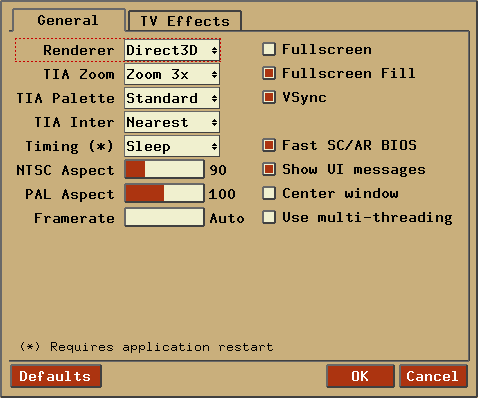 |
|
| Item | Brief description | For more information,
see CommandLine |
|---|
| Renderer | Use specified rendering mode | -video |
| TIA Zoom | (Integral) zoom level for emulation mode | -tia.zoom |
| TIA Palette | Palette for emulation mode | -palette |
| TIA Inter | Interpolation for TIA image | -tia.inter |
| Timing (*) | How to wait between frames (requires restart) | -timing |
| NTSC Aspect | Width of TIA image in NTSC mode | -tia.aspectn |
| PAL Aspect | Width of TIA image in PAL mode | -tia.aspectp |
| Framerate | Frames per second in emulation mode | -framerate |
| Fullscreen | Self-explanatory | -fullscreen |
| Fullscreen Fill | Completely fill TIA image in fullscreen | -tia.fsfill |
| VSync | Enable vertical sync'ed updates | -vsync |
| Fast SC/AR BIOS | Skip progress loading bars for SuperCharger ROMs | -fastscbios |
| Show UI messages | Overlay UI messages onscreen | -uimessages |
| Center window | Attempt to center application window | -center |
| Use multi-threading | Enable multi-threaded rendering | -threads |
|
Video Settings dialog (TV Effects):
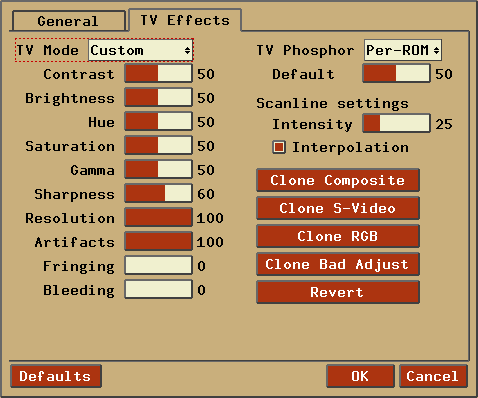 |
|
| Item | Brief description | For more information,
see CommandLine |
|---|
| TV Mode | Disable TV effects, or select TV preset | -tv.filter |
| TV Phosphor | Enable phosphor mode under what conditions | -tv.phosphor |
| Phosphor (Default) | Default blend level to use in phosphor mode
(needs to be manually set for your particular hardware) | -tv.phosblend |
| Scanline Intensity | Sets scanline black-level intensity | -tv.scanlines |
| Scanline Interpolation | Smooth/blend scanlines into image | -tv.scaninter |
| Adjustable sliders | Set specific attribute in 'Custom' mode | -tv.contrast, tv.hue, etc. |
| Clone Composite | Copy 'Composite' attributes to 'Custom' sliders | |
| Clone S-Video | Copy 'S-Video' attributes to 'Custom' sliders | |
| Clone RGB | Copy 'RGB' attributes to 'Custom' sliders | |
| Clone Bad Adjust | Copy 'Bad Adjust' attributes to 'Custom' sliders | |
| Revert | Revert attribute sliders to saved 'Custom' settings | |
|
Audio Settings dialog:
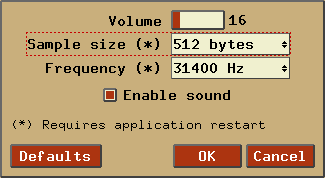 |
|
| Item | Brief description | For more information,
see CommandLine |
|---|
| Volume | Self-explanatory | -volume |
| Sample size (*) | Set size of audio buffers | -fragsize |
| Frequency (*) | Change sound output frequency | -freq |
| Enable sound | Self-explanatory | -sound |
|
Input Settings dialog:
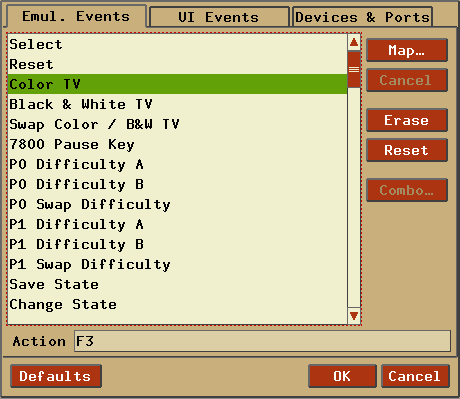 |
|
This dialog is described in further detail in
Advanced Configuration - Event Remapping. |
UI Settings dialog (2 tabs):
 |
|
This tab is described in further detail in
Advanced Configuration - ROM Launcher. |
 |
|
| Item | Brief description | For more information,
see CommandLine |
|---|
| Interface Palette | Palette to use for UI elements | -uipalette |
| List quick delay | Time to wait between keypresses in list-widgets | -listdelay |
| Mouse wheel scroll | Number of lines mouse scroll will move in list-widgets | -mscroll |
|
Snapshot Settings dialog:
 |
|
| Item | Brief description | For more information,
see CommandLine |
|---|
| Save path | Specifies where to save snapshots | -snapsavedir |
| Load path | Specifies where to load snapshots | -snaploaddir |
| Save snapshots according to | Specifies how to name saved snapshots | -snapname |
| Continuous snapshot interval | Interval (in seconds) between snapshots | -ssinterval |
| Overwrite existing files | Whether to overwrite old snapshots | -sssingle |
| Ignore scaling (1x mode) | Save snapshot in 1x mode without scaling | -ss1x |
|
Config Paths dialog:
 |
|
| Item | Brief description | For more information,
see CommandLine |
|---|
| ROM path | Specifies location of ROM files
(only enabled in ROM launcher mode) | -romdir |
| Cheat file | Specifies location of cheatfile database | -cheatfile |
| Palette file | Specifies location of user palette | -palettefile |
| Properties file | Specifies location of external stella.pro database | -propsfile |
| State path | Specifies location of state files | -statedir |
| NVRAM path | Specifies location of NVRAM (flash/EEPROM) files | -nvramdir |
|
Audit ROMs dialog:
 |
|
This dialog is described in further detail in
Advanced Configuration - ROM Audit Mode. |
Game Properties dialog:
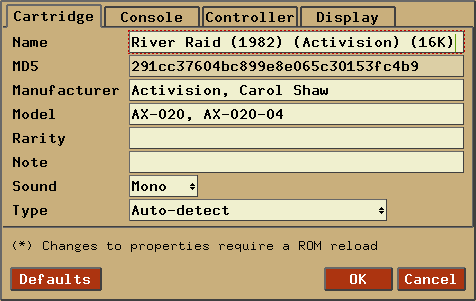 |
|
This dialog allows you to change all ROM properties
as described in Advanced Configuration - Game Properties.
|
Developer Settings dialog:
Almost every event in Stella can be remapped to another key on the keyboard or
to buttons on up to eight joysticks/gamepads (see Getting Started -
Keyboard Layout for those events which can/cannot be
remapped).
Note that there are currently two separate event modes in Stella; emulation
mode and user-interface (UI) mode. Each mode has separate mappings, so (for example)
while in emulation mode, the left arrow could mean 'joystick 0 left', while in UI
mode it could mean 'move cursor left'. Emulation mode occurs whenever you're
actually playing a game. UI mode occurs whenever a user interface is present
(ROM launcher, debugger, settings menu, etc.). Because of these different modes,
there are two separate mapping areas.
To remap an event:
- Enter Options Menu and click the Input Settings button.
- If you wish to remap emulation events, click the 'Emul. Events' tab.
Otherwise, click the 'UI Events' tab for user interface events.
- Select event you want to remap and click the 'Map' button.
- Press a key or a joystick button, and that key/button will be bound
to the selected event. If nothing seems to happen, either Stella
can't see the input device, or the selected event doesn't support being
remapped to the input device.
- Cancel a remap in progress by clicking 'Cancel', erase a mapping by
clicking 'Erase', or reset to default mapping by clicking 'Reset'
- Reset to default all mappings by clicking 'Defaults'.
The following screenshots illustrate the event remapping process:

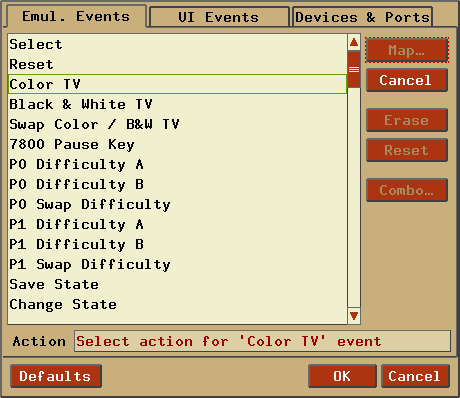
There is also a 'Combo' button in the 'Emul. Events' tab, accessible
when a Combo event has been selected from the list of events on the left.
Clicking 'Combo' will show a dialog similar to the following:

In this dialog, you can assign various events to the selected combo event.
Note that this simply assigns multiple events to the combo; you still need
to map the combo event itself to some action, as described in the 'remap an
event' section above.
Device and port settings can be configured under the 'Devices & Ports' tab, shown below:
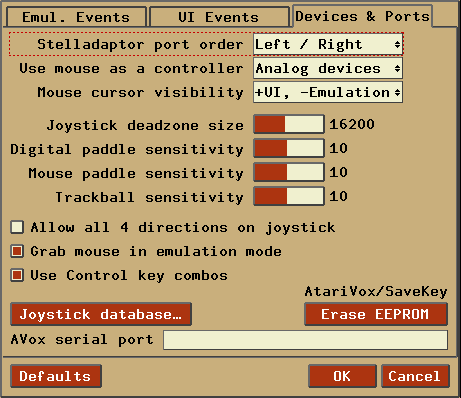 |
|
| Item | Brief description | For more information,
see CommandLine |
|---|
| Stelladaptor port order | Specifies which virtual port each Stelladaptor/2600-daptor uses (See Advanced Configuration - Stelladaptor/2600-daptor Support) | -saport |
| Use mouse as ... | Allow the mouse to emulate various controllers | -usemouse |
| Mouse cursor visibility | Show/hide cursor depending on current state | -cursor |
| Joystick deadzone size | Deadzone area for axes on joysticks/gamepads | -joydeadzone |
| Digital paddle sensitivity | Sensitivity used when emulating a paddle using a digital device | -dsense |
| Mouse paddle sensitivity | Sensitivity used when emulating a paddle using a mouse | -msense |
| Trackball sensitivity | Sensitivity used when emulating a trackball device using a mouse | -tsense |
| Allow all 4 directions ... | Allow all 4 joystick directions to be pressed simultaneously | -joyallow4 |
| Grab mouse ... | Keep mouse in window in emulation mode
(only when used as controller) | -grabmouse |
| Use Control key combos | Enable using Control key in keyboard actions | -ctrlcombo |
| Joystick Database | Show all joysticks that Stella knows about, with the option to remove them | |
| Erase EEPROM | Erase the whole AtariVox/SaveKey flash memory | |
| AVox serial port | Described in further detail in Advanced Configuration - AtariVox/SaveKey Support | -avoxport |
|
Several options are configurable in the ROM launcher. The size of the
launcher and fonts, as well as the 'ROM Info Viewer' can be changed in
UI Settings - Launcher dialog, as shown below:

Most of the options are self-explanatory, except for the 'ROM Info
viewer', which is described below.
Stella supports viewing snapshots and ROM properties of the currently
selected ROM in the ROM launcher. Support is automatic, as long as your
snapshot directory contains snapshots in the appropriate format. An
archive of updated snapshots will be available on the Stella webpage.
This archive may be updated periodically as new ROMs are found, and also
for each new release of Stella. Note that the snapshots can be any size
generated by Stella; they will be resized accordingly.
Currently, there are several restrictions for this feature:
- The ROM Info Viewer can be shown in 1x or 2x mode only.
- To view snapshots in 1x mode, the ROM launcher window must be sized at
least 640x480. If the launcher isn't large enough, the functionality
will be disabled.
- To view snapshots in 2x mode, the ROM launcher window must be sized at
least 1000x760. If the launcher isn't large enough, an attempt will
be made to use 1x mode.
The following snapshots illustrate the various font sizes and rom info
zoom levels:
ROM Info Viewer in 1x mode, UI sized 800x480, small launcher font:
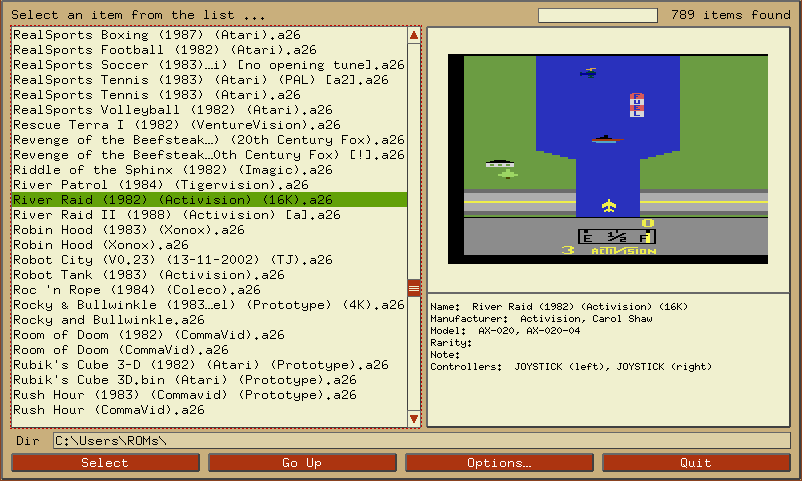
ROM Info Viewer in 1x mode, UI sized 1000x760, medium launcher font:

ROM Info Viewer in 2x mode, UI sized 1400x900, large launcher font:
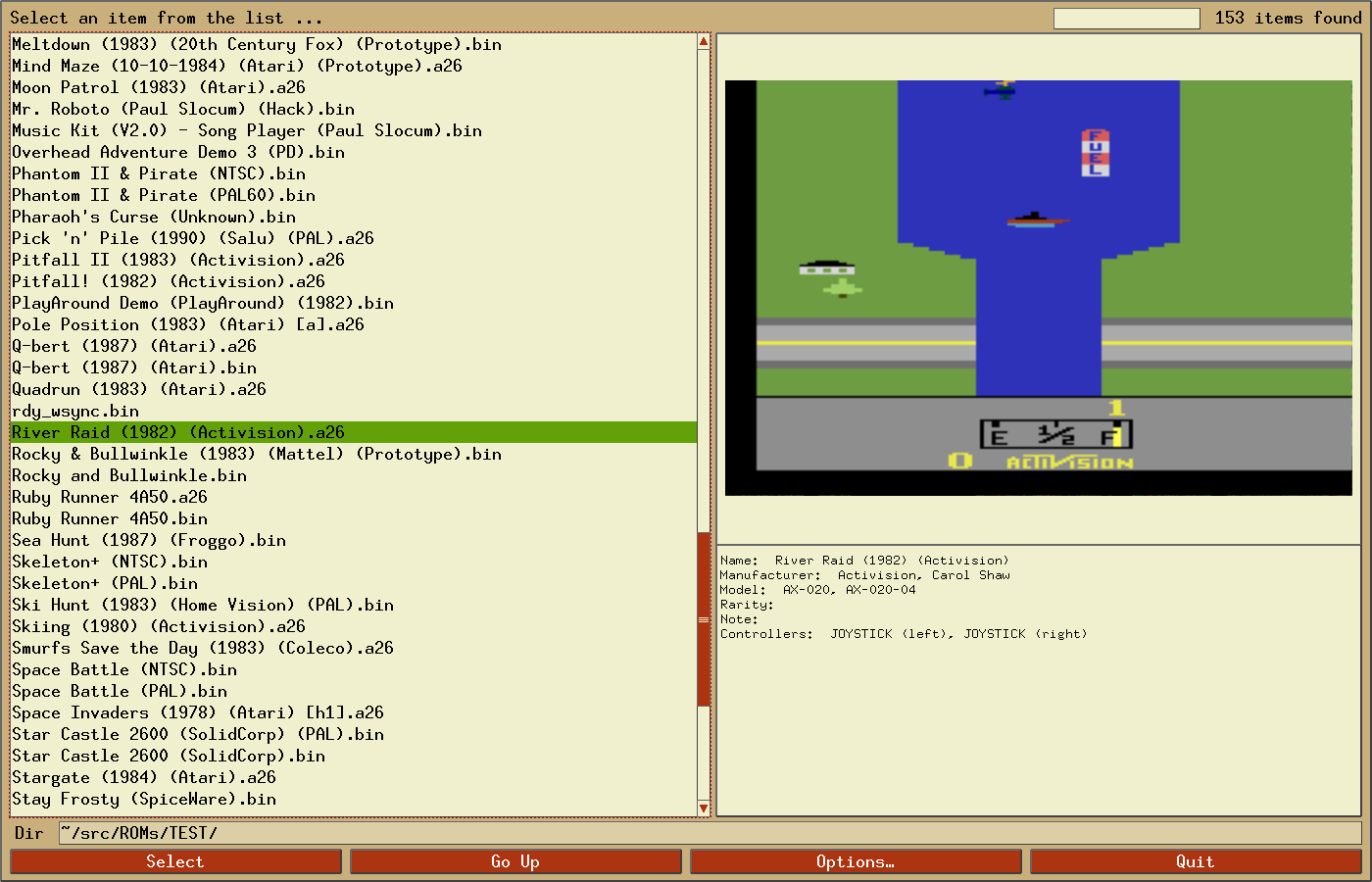
The text box in the upper right corner can be used to narrow down the
results in the ROM listing. When this box is empty, all files are shown
(subject to the restrictions from the filtering option, explained below).
Typing characters here will show only those files that match that
pattern. For example, typing 'Activision' will show only files that
contain the word 'Activision' in their name. This is very useful for
quickly finding a group of related ROMs. Note that the search is not
case sensitive, so you don't need to worry about capital or lower-case
letters.
The ROM launcher also contains a context menu, selected by clicking the
right mouse button anywhere in the current window. This context menu
contains the following items:
Power-on options: Selecting this option shows a dialog whereby
ROM properties can be temporarily overridden, and joystick/console buttons can be
temporarily held down. Selecting options from this dialog will cause all ROMs launched
after that to use those properties you specify. Clicking Defaults will disable
its functionality, and use ROM properties as defined by the ROM itself. The dialog is as
follows (See Advanced Configuration - Game Properties
for more information concerning ROM properties):
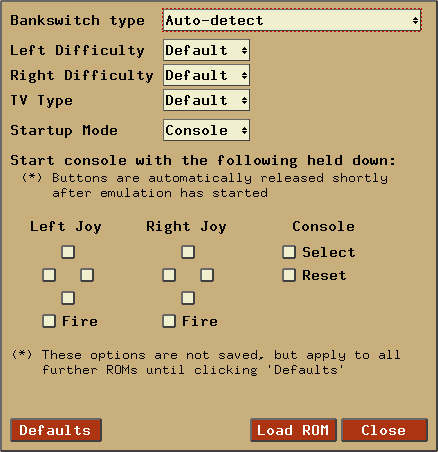 |
|
| Item | For more information,
see Commandline |
|---|
| Bankswitch type | -bs |
| Left Difficulty | -ld |
| Right Difficulty | -rd |
| TV Type | -tv |
| Startup Mode | -debug |
| Left Joy items | -holdjoy0 |
| Right Joy items | -holdjoy1 |
| Console: Select | -holdselect |
| Console: Reset | -holdreset |
|
Filter listing: Selecting this option shows a dialog whereby
one can filter the types of files shown in the listing. The dialog is as
follows:

Currently, the choices are as follows:
- All files - self explanatory, show all files in the ROM
listing. This is the default, and emulates the behaviour of
all previous versions of Stella.
- All roms - show only files with a valid ROM extension.
Currently, this means extensions .a26, .bin, .rom, .gz, .zip.
- ROMs ending with - show only files with a ROM extension
as selected from the checkboxes.
- Reload listing: Selecting this performs a reload of the
current listing. It is an alternative to pressing the Control-r
key combo.
Stella has the ability to rename all your ROMs according to the name
specified in the properties database. This is useful if you've downloaded
ROMs in DOS 8.3 naming format, and wish the filenames to be more descriptive,
or the current filenames are too large to see in the launcher.
This feature is accessible from Options => Audit ROMs, and is only
available while in ROM launcher mode. The dialog box for this feature
is as follows:

Simply select the ROM path with the 'Audit path' button, and click the
'Audit' button. The ROMs will then be renamed according to their internal
properties. When the operation is complete, the number of ROMs that were
renamed (as well as ones that weren't) will be shown.
There are several items to take note of:
- THIS OPERATION CANNOT BE UNDONE. I cannot stress this
enough; if you aren't completely sure you want to rename your ROMs,
don't use this function. There is no undo feature, and one won't be
added.
- Only filenames that Stella considers to be valid ROMs will be
considered. Currently, this means files that end in '.a26',
'.bin', '.rom', '.gz' and '.zip'. Files which don't have these
extensions will be ignored.
- If a valid ROM doesn't have a properties entry, it will be
ignored.
Stella supports real Atari 2600 joysticks, paddles and driving controllers
using the Stelladaptor and
2600-daptor devices.
Stella can use up to two adaptors; any extra ones are ignored.
Stelladaptor devices will be automatically detected and configured. The
actual controllers can be plugged/unplugged while the emulator is running,
although you will need to restart the game currently being emulated.
The detection and configuration is as follows:
- The first device found will act as the left game port
on a real Atari. Depending on the device, Stella will detect it as
either the left joystick, paddles 0 & 1, the left driving controller,
left keypad, etc.
- The second device found will act as the right game port
on a real Atari. Depending on the device, Stella will detect it as
either the right joystick, paddles 2 & 3, the right driving controller,
right keypad, etc.
- Any other devices will be ignored.
- The assignment ordering of Stelladaptor/2600-daptor to port can be redefined with
'saport' (see description in Using the Command Line) and dynamically with the 'Control-1' key
combo.
Stella supports a real AtariVox device for the speech/SpeakJet portion
of the controller. You will need a real AtariVox device
as well as some means of connecting it to your computer (some sort of
serial port/USB adaptor). There should be drivers for your serial convertor,
which allow your particular operating system to 'see' the device (configuring
this is outside the scope of this document). Once your operating system
properly detects the AtariVox, you will need to tell Stella which serial
port it is connected to. This is done by using the '-avoxport' commandline
argument, or by setting it in the UI under the 'Devices & Ports' tab in
Advanced Configuration - Input Devices.
Note that you must use the entire name of the port as specified by
your operating system. For example, in Windows this would be COM1,
COM2, etc.; Linux and MacOSX tend to use names similar to '/dev/xxxxxx'.
For now, only Linux/UNIX, MacOSX, and Windows are supported.
Support for the EEPROM portion of the AtariVox and SaveKey is currently
emulated. That is, a file will be created on your computer simulating the
EEPROM; the actual EEPROM hardware itself will not be accessed or modified.
This is very useful in the testing stages of creating a new game, since
writing to a real EEPROM many times will eventually wear it out.
The location of the EEPROM files are configurable through the
'-nvramdir' commandline argument and within the application itself
(see Advanced Configuration - Config Paths).
If the path for these files hasn't been set, the default location will depend on the
version of Stella, as follows:
| Linux/Unix |
~/.stella/nvram/atarivox_eeprom.dat
~/.stella/nvram/savekey_eeprom.dat |
| Macintosh |
~/Library/Application Support/Stella/nvram/atarivox_eeprom.dat
~/Library/Application Support/Stella/nvram/savekey_eeprom.dat |
| Windows |
%APPDATA%\Stella\nvram\atarivox_eeprom.dat
%APPDATA%\Stella\nvram\savekey_eeprom.dat
OR
_BASEDIR_\nvram\atarivox_eeprom.dat
_BASEDIR_\nvram\savekey_eeprom.dat
(if a file named 'basedir.txt' exists in the application
directory containing the full pathname for _BASEDIR_)
|
Note that these EEPROM files will be created when necessary, and
initialized as a real EEPROM would be (containing all $FF). The
files can be manually deleted, which is very useful in testing
cases where a ROM is accessing the EEPROM for the first time. You can also
reset the EEPROM to a clean state.
Several developer related options can be configured in the 'Developer Settings' dialog.
Two sets ('Player settings', 'Developer settings') allow easy adjustment of all settings
for different use cases (playing or developing games) at once.
Developer Settings dialog (Emulator)
 |
|
| Item | Brief description | For more information,
see CommandLine |
|---|
| Player/Developer settings | Selects the active settings set | -dev.settings |
| Frame Statistics | Overlay console info on the TIA image during emulation. | -plr.stats
-dev.stats |
| Console | Select the console type, this affects Color/B&W/Pause key emulation and zero-page RAM initialzation | -plr.console
-dev.console |
| Random startup bank | Randomize the startup bank (only for selected bankswitch types) | -plr.bankrandom
-dev.bankrandom |
| Randomize zero-page ... | When loading a ROM, randomize all RAM content instead of initializing with all zeroes (for 'Console' = 'Atari 2600' only) | -plr.ramrandom
-dev.ramrandom |
| Randomize CPU | When loading a ROM, randomize the content of the specified CPU registers | -plr.cpurandom
-dev.cpurandom |
| Drive unused TIA pins ... | Unused TIA pins are read random instead of the last databus values | -plr.tiadriven
-dev.tiadriven |
| Fatal ARM emulation ... |
Thumb ARM emulation throws an exception and enters the debugger on fatal errors |
-plr.thumb.trapfatal
-dev.thumb.trapfatal |
|
Developer Settings dialog (Video):
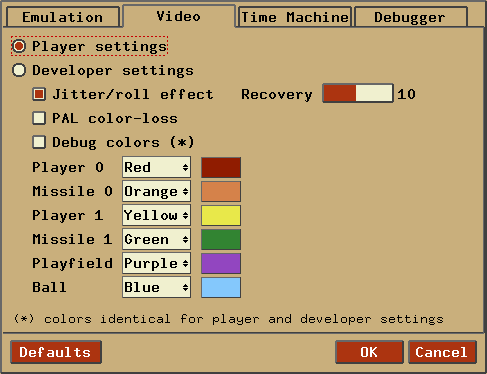 |
|
| Item | Brief description | For more information,
see CommandLine |
|---|
| Jitter/roll effect | Emulate screen roll with inconsistent scanline count | -plr.tv.jitter
-dev.tv.jitter |
| (Jitter/roll) Recovery | Determines recovery time for screen rolling | -plr.tv.jitter_recovery
-dev.tv.jitter_recovery |
| PAL color-loss | Use PAL color-loss effect | -plr.colorloss
-dev.colorloss |
| Debug colors | Use fixed debug colors | -plr.debugcolors
-dev.debugcolors |
Player 0
Missile 0
Player 1
Missile 1
Playfield
Ball
|
Set color for specific object in 'Debug Colors' mode
(PF0, PF1 and PF2 have a slightly different luminance)
Disabled in ROM launcher mode | -tia.dbgcolors
|
|
Developer Settings dialog (Time Machine)
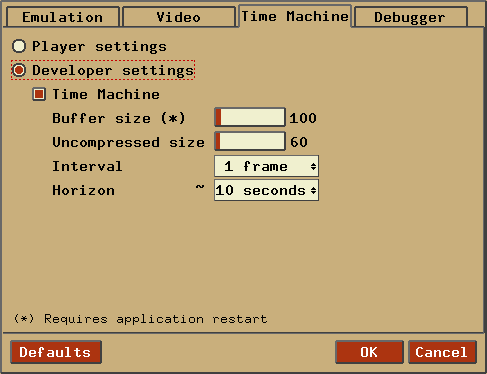 |
|
| Item | Brief description | For more information,
see CommandLine |
| Time Machine |
When the Time Machine is enabled, Stella will automatically
buffer save states in the interval described below. The user
can then navigate back and forth within the recorded timeline.
Note: This buffer is identical with the one described in
Debugger - Global Buttons.
It is independent from the save states manually created with F9.
|
-plr.timemachine
-dev.timemachine |
| Buffer size |
Defines the Time Machine buffer size. The larger the buffer, the less
save states have to be compressed to reach the horizon.
|
-plr.tm.size
-dev.tm.size |
| Uncompressed size (*) |
Defines the uncompressed Time Machine buffer size. States within this
area will not be compressed and keep their initial interval. |
-plr.tm.uncompressed
-dev.tm.uncompressed |
| Interval |
Defines the interval between two save states when they are created. |
-plr.tm.interval
-dev.tm.interval |
| Horizon |
Defines the horizon of the Time Machine. A large horizon allows
going back further in time. To reach the horizon, save states
will be compressed (*). This means that more and more intermediate
states will be removed and the interval between save states
becomes larger the further they are back in time. The very first
save state will not be removed.
(*) Compresion only works if 'Uncompressed size' is smaller than
'Buffer size'.
|
-plr.tm.horizon
-dev.tm.horizon |
|
Developer Settings dialog (Debugger)
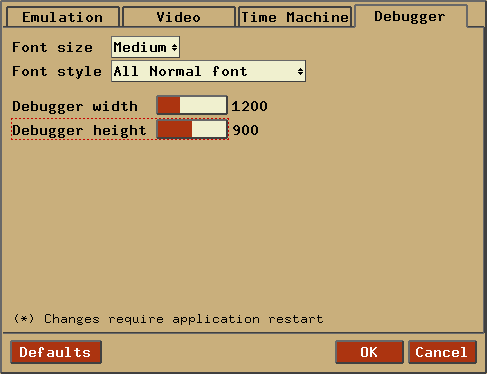 |
|
| Item | Brief description | For more information,
see CommandLine |
|---|
| Font size | Self-explanatory (requires ROM reload) | -dbg.fontsize |
| Font style | Self-explanatory (requires ROM reload) | -dbg.fontstyle |
| Debugger width/height | Self-explanatory (requires ROM reload) | -dbg.res |
|
Many more options are available for ROM developers, which are described in
different sections of this manual, as follows:
Finally, Stella contains an extensive, built-in debugger. Have a look at
this page for integrated debugger documentation.
Stella will remember when you change a setting either at the command line
or while the emulation is running, and use the settings the next time
you start the emulator. The settings are saved in a text file which can
be edited outside of Stella. This file can contain your default options,
and eliminates the need to specify them on the command line. Any
options specified on the command line will override those in the settings file.
The syntax for the settings file is very straightforward. Any line starting with
a ';' character is considered a comment and is ignored. Other lines must be of
the form: command = value, where command is the same as that
specified on the command line (without the '-' character), and value
is dependent on the command.
For example, the following table illustrates how command line and settings entries
are similar:
| Command Line |
Settings File |
| -video opengl |
video = opengl |
| -volume 75 |
volume = 75 |
| -center 1 |
center = 1 (or center = true) |
The settings file has a special name/location depending on which version of Stella
you use, which is currently not configurable:
| Linux/Unix |
$HOME/.config/stella/stellarc |
| Macintosh |
Not applicable; settings are saved in ~/Library/Preferences/Stella-emu.plist |
| Windows |
%APPDATA%\Stella\stella.ini
OR
_BASEDIR_\stella.ini
(if a file named 'basedir.txt' exists in the application
directory containing the full pathname for _BASEDIR_)
|
Stella contains support for Bob Colbert's Cheetah cheat codes, as
well as an extended Stella-specific type of cheat code that works on
bankswitched ROMs.
To add/remove/edit a cheat code, enter the 'Cheat Code' dialog:

Currently, there are three types of cheatcodes available, all of which
must be entered in hexadecimal format:
Per-frame RAM cheats:
Evaluated each frame, and apply to RAM only. Format as follows:
4-digit code: c041
c0 = address
41 = data
- Cheetah codes, which are explained in detail on
Bob Colbert's web page,
along with a list of codes for various games. Cheetah codes
don't support bankswitched ROMs, so they only work for 2K or 4K ROMs.
Format as follows:
6-digit (cheetah) code: aaaddc
aaa = address - $f000
dd = data
c = count - 1
- Stella extended cheats are similar to Cheetah codes, except that
they can be 7 or 8 digits long, with the extra digits used for the
bank number:
7-digit (stella) code: baaaddc
b = bank (0 to $f)
aaa = address - $f000
dd = data
c = count - 1
8-digit (stella) code: bbaaaddc
bb = bank (0 to $ff)
aaa = address - $f000
dd = data
c = count - 1
There's also the concept of one shot codes. These codes work
exactly the same as above, except they aren't saved. They are evaluated
once and immediately discarded.
Here are a few cheat codes we've found:
Pitfall (standard Cheetah codes):
5b0ea1 - infinite lives
723ea1 - infinite time
aa5??0 - set starting level, ?? = 01 to ff (d0 is kinda neat)
Battlezone (Stella extended codes):
1236ea1 - infinite lives
Ms Pac-Man (Stella extended codes):
108fea1 - infinite lives
The name of the cheat database file is configurable through the
'-cheatfile' commandline argument and within the application itself
(see Advanced Configuration - Config Paths). If the
path for this file hasn't been set, the default filename will depend on the
version of Stella, as follows:
| Linux/Unix |
$HOME/.config/stella/stella.cht |
| Macintosh |
~/Library/Application Support/Stella/stella.cht |
| Windows |
%APPDATA%\Stella\stella.cht
OR
_BASEDIR_\stella.cht
(if a file named 'basedir.txt' exists in the application
directory containing the full pathname for _BASEDIR_)
|
Stella will require a restart for changes to this file to take effect.
Stella maintains a log of its operations when the program first starts up, and
while it is running. In older releases, this information was only viewable from the
commandline. However, the current release allows
you to see this information from within the UI. This can be selected from the main
Options menu, where it is labelled "System Logs". Clicking on the button will show
a window similar to the following:
 |
|
| Item | For more information,
see Commandline |
|---|
| Log level | -loglevel |
| Print to console | -logtoconsole |
|
The log levels are self-explanatory (None, Basic, Verbose). The "Print to console"
option emulates the behaviour of older versions of Stella, whereby the logged output
is also shown on the commandline from which Stella was launched (if it was launched
in that fashion). Finally, the current contents of the system log can be saved to your
home directory by clicking the "Save log to disk" button.
Stella uses game properties to specify the "best" emulator settings for a
game. As of version 2.2 of Stella, a default database of properties are
built-in, but you may modify these through the use of a stella.pro file
or within the corresponding Game Properties dialogs.
This file will contain all properties modified by the user. So this
means that when you upgrade Stella, your personal properties settings are
preserved.
Property File
A property file consists of some number of blocks. Each block in the file
contains the properties for a single game. For example the general format of
a property file is:
; Comments
"Cartridge.MD5" "Value"
"Property" "Value"
""
; Comments
"Cartridge.MD5" "Value"
"Property" "Value"
""
. . .
; Comments
"Cartridge.MD5" "Value"
"Property" "Value"
""
Every block in the property file must have a unique value for the
Cartridge.MD5 property.
Properties
Each block in a property file consists of a set of properties for a single
game. Stella supports the properties described below:

| Cartridge.MD5: |
Indicates the MD5 checksum of the ROM image as a
string of hexadecimal digits. Stella uses this property while
attempting to match a game with its block of properties. If the
value of the property matches the MD5 checksum of the ROM image then
Stella uses that block of properties for the game. You can use the
GNU md5sum program, which is included with most Linux distributions,
to calculate the MD5 checksum of a ROM image. |
| Cartridge.Manufacturer: |
Indicates the game's manufacturer. |
| Cartridge.ModelNo: |
Indicates the manufacturer's model number for the game. |
| Cartridge.Name: |
Indicates the actual name of the game. When you save snapshots,
load/save state files, or use the ROM Audit Mode functionality,
this is the name that will be used for the respective file(s). |
| Cartridge.Note: |
Contains any special notes about playing the game. |
| Cartridge.Rarity: |
Indicates how rare a cartridge is, based on the scale described on AtariAge. |
| Cartridge.Sound: |
Indicates if the game should use 1 or 2 channels for sound output.
All original Atari 2600 machines supported 1 channel only,
but some homebrew games have been written to take advantage of stereo
sound mods. The value must be Mono or Stereo. |
| Cartridge.Type: |
Indicates the bank-switching type for the game.
The value of this property must be either Auto or one of the following
(for more information about bank-switching see Kevin Horton's 2600 bankswitching
document or the documentation in each cartridges source code file). Types marked
as (¹) do not currently have reliable auto-detection, those marked as (²)
are not fully supported in the debugger:
| Type | Description |
|---|
| 0840 | 8K ECONObanking |
| 2IN1 ¹ | 4-32K Multicart (2 games) |
| 4IN1 ¹ | 8-32K Multicart (4 games) |
| 8IN1 ¹ | 16-64K Multicart (8 games) |
| 16IN1 ¹ | 32-128K Multicart (16 games) |
| 32IN1 ¹ | 64-128K Multicart (32 games) |
| 64IN1 ¹ | 64/128K Multicart |
| 128IN1 ¹ | 256/512K Multicart |
| 2K | 64-2048 byte Atari |
| 3E | 32K Tigervision |
| 3E+ | 3E+ (TJ modified DASH) |
| 3F | 512K Tigervision |
| 4A50 ² | 64K 4A50 + ram |
| 4K | 4K Atari |
| 4KSC | CPUWIZ 4K + ram |
| AR | Supercharger |
| BF | CPUWIZ 256K |
| BFSC | CPUWIZ 256K + ram |
| BUS | Experimental |
| CDF | Chris, Darrell, Fred |
| CM ¹ | Spectravideo CompuMate |
| CTY ¹² | CDW - Chetiry |
| CV | Commavid extra ram |
| CV+ | Extended Commavid extra ram |
| DASH | Boulder Dash 2 |
| DF | CPUWIZ 128K |
| DFSC | CPUWIZ 128K + ram |
| DPC | Pitfall II |
| DPC+ | Enhanced DPC |
| E0 | 8K Parker Bros |
| E7 | 16K M-network |
| E78K | 8K M-network |
| EF | 64K Homestar Runner |
| EFSC | 64K Homestar Runner + ram |
| F0 | Dynacom Megaboy |
| F4 | 32K Atari |
| F4SC | 32K Atari + ram |
| F6 | 16K Atari |
| F6SC | 16K Atari + ram |
| F8 | 8K Atari |
| F8SC | 8K Atari + ram |
| FA | CBS RAM Plus |
| FA2 | CBS RAM Plus 24/28K |
| FE | 8K Decathlon |
| MDM | Menu Driven Megacart |
| SB | 128-256k SUPERbanking |
| UA | 8K UA Ltd. |
| WD | Wickstead Design |
| X07 ¹ | 64K AtariAge |
|
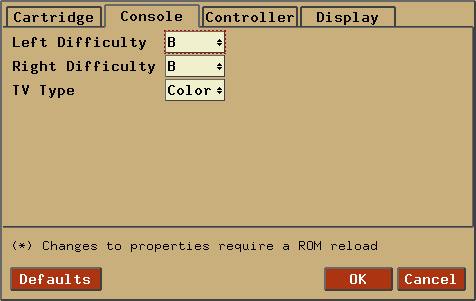
| Console.LeftDifficulty: |
Indicates the default difficulty setting for the left
player. The value must be A or B. |
| Console.RightDifficulty: |
Indicates the default difficulty setting for the
right player. The value must be A or B. |
| Console.TelevisionType: |
Indicates the default television setting for the
game. The value must be Color or BW. |
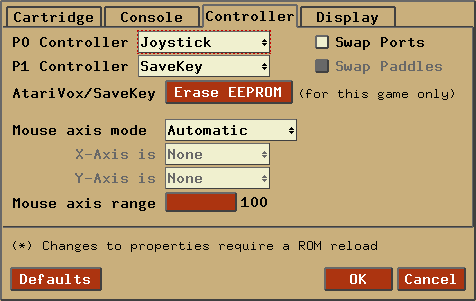
Controller.Left:
Controller.Right: |
Indicates what type of controller the left and right player
uses. The value must be one of the following types:
| Type | Description |
|---|
| Joystick | Atari's famous black joystick that was originally included with the system. |
| BoosterGrip | A controller add-in that plugs directly into the joystick port and provides a pass-through for the joystick. In doing so, it provides the two independent buttons. |
| Paddles | Standard paddle controllers for use with games such as Breakout and Warlords. One pair of controller per connector (allows for 4-player Warlords). |
| Paddles_IAxis | Same as Paddles, except the axes are inverted. |
| Paddles_IDir | Same as Paddles, except the direction of movement is inverted. |
| Paddles_IAxDr | Same as Paddles, except both the axes and direction of movement is inverted. |
| Driving | Looks like a paddle, but allows 360' movement. Only one unit per connector, unlike paddles which were sold in pairs. |
| Keyboard | Also known as the Star Raiders controller, functionally identical to the Kid's Controller and Keyboard Controller. Game included an overlay with commands, for use with Star Raiders. |
| AmigaMouse | Commodore Amiga computer mouse. |
| AtariMouse | Atari ST computer mouse. |
| Trakball | Standard Atari 2600 CX22/CX80 'Trak-Ball' controller. |
| AtariVox | A SpeakJet based unlimited-vocabulary speech/sound synthesizer with 32K EEPROM. |
| SaveKey | A 32K EEPROM for saving high scores, etc. (the EEPROM portion of an AtariVox). |
| Genesis | Sega Genesis controller, which can be used similar to a BoosterGrip, giving an extra button. |
| CompuMate | Spectravideo CompuMate (if either left or right is set, CompuMate is used for both). |
| Mindlink | Mindlink controller. |
|
https://atariage.com/2600/programming/atarivox_mem_list.html
| Console.SwapPorts: |
Indicates that the left and right ports should be
swapped internally. This is used for ROMs like 'Raiders of the Lost Ark' where the
Player 0 joystick is plugged into the right joystick port.
The value must be Yes or No. |
| Controller.SwapPaddles: |
Indicates that the left and right paddles in
a particular port should be swapped. This is used for ROMs like
'Demons to Diamonds' where the default paddle is paddle 1, not
paddle 0. Other ROMs such as 'Tac-Scan' default to paddle 3,
which can be set using both 'Controller.SwapPaddles' and
'Console.SwapPorts'. The value must be Yes or No. |
| Controller.MouseAxis: |
Indicates how the mouse should emulate virtual controllers.
In 'Auto' mode, the system decides how to best use the mouse. Otherwise,
XY indicates how to use the X/Y axis (ie, 02 is paddle0/paddle2).
Currently, the mouse X-axis and left button are tied together, as are the
Y-axis and right button. The value must be Auto or XY, as follows:
| Id | Controller |
|---|
| 0 | Paddle 0 |
| 1 | Paddle 1 |
| 2 | Paddle 2 |
| 3 | Paddle 3 |
| 4 | Driving 0 |
| 5 | Driving 1 |
| 6 | MindLink 0 |
| 7 | MindLink 1 |
An optional second parameter (default of 100) indicates how much
of the paddle range that the mouse should emulate.
|
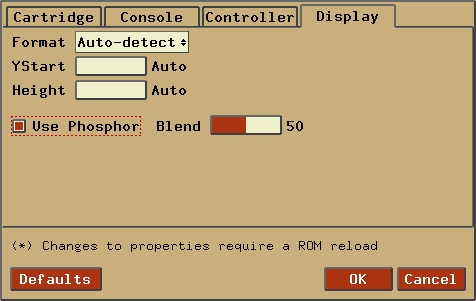
| Display.Format: |
Indicates the television format the game was designed for. The value
must be Auto, NTSC, PAL, SECAM, NTSC50,
PAL60 or SECAM60. |
| Display.YStart: |
Indicates the scan-line to start displaying at.
The value must be n such that 0 <= n <= 64.
Setting n to zero will enable ystart autodetection, which
should work fine for the vast majority of ROMs. |
| Display.Height: |
Indicates the number of scan-lines to display.
The value must be n such that 210 <= n <= 256. |
| Display.Phosphor: |
Indicates whether the phosphor effect should be emulated or not.
The value must be Yes or No. |
| Display.PPBlend: |
Indicates the amount of blending which will occur while using the
phosphor effect. The value must be n such that 0 <= n
<= 100. The default value is whatever is specified for tv.phosblend. |
The name of the properties file is configurable through the
'-propsfile' commandline argument and within the application itself
(see Advanced Configuration - Config Paths). If the
path for this file hasn't been set, the default filename will depend on the
version of Stella, as follows:
| Linux/Unix |
$HOME/.config/stella/stella.pro |
| Macintosh |
~/Library/Application Support/Stella/stella.pro |
| Windows |
%APPDATA%\Stella\stella.pro
OR
_BASEDIR_\stella.pro
(if a file named 'basedir.txt' exists in the application
directory containing the full pathname for _BASEDIR_)
|
Stella will require a restart for changes to this file to take effect.
An Atari 2600 palette consists of 128 colours, which are different
for the three major television standards (NTSC, PAL, SECAM).
Stella supports two built-in palettes and one user-defined palette for each format.
These are set using the '-palette' option, and are described as follows:
| standard |
The default palette from Stella 1.4 onwards. |
| z26 |
The palette from the z26 emulator. |
| user |
An external palette file, supplied by the user. |
A user-defined palette has certain restrictions, further described as follows:
- The palette file must be at least 792 bytes long. Colours are stored
in 24-bit RGB, with the first byte for red, the second for green, the
third for blue, for a total of 3 bytes per colour.
- The first 384 bytes of the file (128 * 3) will be used for the NTSC
palette. The next 384 bytes (128 * 3) will be for the PAL palette.
The next 24 bytes (8 * 3) will be for the SECAM palette, which
consists of eight distinct colours. Any extra data in the file
will be ignored.
- The PAL colour-loss effect is calculated within Stella. You do not
need to specify those colours in the palette file.
The name of the palette file is configurable through the
'-palettefile' commandline argument and within the application itself
(see Advanced Configuration - Config Paths). If the
path for this file hasn't been set, the default filename will depend on the
version of Stella, as follows:
| Linux/Unix |
$HOME/.config/stella/stella.pal |
| Macintosh |
~/Library/Application Support/Stella/stella.pal |
| Windows |
%APPDATA%\Stella\stella.pal
OR
_BASEDIR_\stella.pal
(if a file named 'basedir.txt' exists in the application
directory containing the full pathname for _BASEDIR_)
|
Note that to actually use the external palette, the palette file must
exist and be valid, and the palette option should be set to user
(in Video Settings dialog). The current ROM will have to be reloaded
for changes to this file to take effect.
Bradford W. Mott started developing Stella during the fall of 1995, and Stephen
Anthony has maintained the project since around 2004. Over the years, a number of people
from around the world have contributed to the project.
Some people have provided technical help while others have offered suggestions
and praise. The Stella Team is grateful for all the help and support it has
received over the years. A (likely incomplete) list of the people who have
played a part in bringing Stella to you is available on the main Stella
webpage Credits List.
If we've missed someone, please let us know.
GNU GENERAL PUBLIC LICENSE
Version 2, June 1991
Copyright (C) 1989, 1991 Free Software Foundation, Inc.
59 Temple Place - Suite 330, Boston, MA 02111-1307, USA
Everyone is permitted to copy and distribute verbatim copies
of this license document, but changing it is not allowed.
Preamble
The licenses for most software are designed to take away your
freedom to share and change it. By contrast, the GNU General Public
License is intended to guarantee your freedom to share and change free
software--to make sure the software is free for all its users. This
General Public License applies to most of the Free Software
Foundation's software and to any other program whose authors commit to
using it. (Some other Free Software Foundation software is covered by
the GNU Library General Public License instead.) You can apply it to
your programs, too.
When we speak of free software, we are referring to freedom, not
price. Our General Public Licenses are designed to make sure that you
have the freedom to distribute copies of free software (and charge for
this service if you wish), that you receive source code or can get it
if you want it, that you can change the software or use pieces of it
in new free programs; and that you know you can do these things.
To protect your rights, we need to make restrictions that forbid
anyone to deny you these rights or to ask you to surrender the rights.
These restrictions translate to certain responsibilities for you if you
distribute copies of the software, or if you modify it.
For example, if you distribute copies of such a program, whether
gratis or for a fee, you must give the recipients all the rights that
you have. You must make sure that they, too, receive or can get the
source code. And you must show them these terms so they know their
rights.
We protect your rights with two steps: (1) copyright the software, and
(2) offer you this license which gives you legal permission to copy,
distribute and/or modify the software.
Also, for each author's protection and ours, we want to make certain
that everyone understands that there is no warranty for this free
software. If the software is modified by someone else and passed on, we
want its recipients to know that what they have is not the original, so
that any problems introduced by others will not reflect on the original
authors' reputations.
Finally, any free program is threatened constantly by software
patents. We wish to avoid the danger that redistributors of a free
program will individually obtain patent licenses, in effect making the
program proprietary. To prevent this, we have made it clear that any
patent must be licensed for everyone's free use or not licensed at all.
The precise terms and conditions for copying, distribution and
modification follow.
TERMS AND CONDITIONS FOR COPYING, DISTRIBUTION AND MODIFICATION
0.
This License applies to any program or other work which contains
a notice placed by the copyright holder saying it may be distributed
under the terms of this General Public License. The "Program", below,
refers to any such program or work, and a "work based on the Program"
means either the Program or any derivative work under copyright law:
that is to say, a work containing the Program or a portion of it,
either verbatim or with modifications and/or translated into another
language. (Hereinafter, translation is included without limitation in
the term "modification".) Each licensee is addressed as "you".
Activities other than copying, distribution and modification are not
covered by this License; they are outside its scope. The act of
running the Program is not restricted, and the output from the Program
is covered only if its contents constitute a work based on the
Program (independent of having been made by running the Program).
Whether that is true depends on what the Program does.
1.
You may copy and distribute verbatim copies of the Program's
source code as you receive it, in any medium, provided that you
conspicuously and appropriately publish on each copy an appropriate
copyright notice and disclaimer of warranty; keep intact all the
notices that refer to this License and to the absence of any warranty;
and give any other recipients of the Program a copy of this License
along with the Program.
You may charge a fee for the physical act of transferring a copy, and
you may at your option offer warranty protection in exchange for a fee.
2.
You may modify your copy or copies of the Program or any portion
of it, thus forming a work based on the Program, and copy and
distribute such modifications or work under the terms of Section 1
above, provided that you also meet all of these conditions:
- a)
You must cause the modified files to carry prominent notices
stating that you changed the files and the date of any change.
- b)
You must cause any work that you distribute or publish, that in
whole or in part contains or is derived from the Program or any
part thereof, to be licensed as a whole at no charge to all third
parties under the terms of this License.
- c)
If the modified program normally reads commands interactively
when run, you must cause it, when started running for such
interactive use in the most ordinary way, to print or display an
announcement including an appropriate copyright notice and a
notice that there is no warranty (or else, saying that you provide
a warranty) and that users may redistribute the program under
these conditions, and telling the user how to view a copy of this
License. (Exception: if the Program itself is interactive but
does not normally print such an announcement, your work based on
the Program is not required to print an announcement.)
These requirements apply to the modified work as a whole. If
identifiable sections of that work are not derived from the Program,
and can be reasonably considered independent and separate works in
themselves, then this License, and its terms, do not apply to those
sections when you distribute them as separate works. But when you
distribute the same sections as part of a whole which is a work based
on the Program, the distribution of the whole must be on the terms of
this License, whose permissions for other licensees extend to the
entire whole, and thus to each and every part regardless of who wrote it.
Thus, it is not the intent of this section to claim rights or contest
your rights to work written entirely by you; rather, the intent is to
exercise the right to control the distribution of derivative or
collective works based on the Program.
In addition, mere aggregation of another work not based on the Program
with the Program (or with a work based on the Program) on a volume of
a storage or distribution medium does not bring the other work under
the scope of this License.
3.
You may copy and distribute the Program (or a work based on it,
under Section 2) in object code or executable form under the terms of
Sections 1 and 2 above provided that you also do one of the following:
- a)
Accompany it with the complete corresponding machine-readable
source code, which must be distributed under the terms of Sections
1 and 2 above on a medium customarily used for software interchange; or,
- b)
Accompany it with a written offer, valid for at least three
years, to give any third party, for a charge no more than your
cost of physically performing source distribution, a complete
machine-readable copy of the corresponding source code, to be
distributed under the terms of Sections 1 and 2 above on a medium
customarily used for software interchange; or,
- c)
Accompany it with the information you received as to the offer
to distribute corresponding source code. (This alternative is
allowed only for noncommercial distribution and only if you
received the program in object code or executable form with such
an offer, in accord with Subsection b above.)
The source code for a work means the preferred form of the work for
making modifications to it. For an executable work, complete source
code means all the source code for all modules it contains, plus any
associated interface definition files, plus the scripts used to
control compilation and installation of the executable. However, as a
special exception, the source code distributed need not include
anything that is normally distributed (in either source or binary
form) with the major components (compiler, kernel, and so on) of the
operating system on which the executable runs, unless that component
itself accompanies the executable.
If distribution of executable or object code is made by offering
access to copy from a designated place, then offering equivalent
access to copy the source code from the same place counts as
distribution of the source code, even though third parties are not
compelled to copy the source along with the object code.
4.
You may not copy, modify, sublicense, or distribute the Program
except as expressly provided under this License. Any attempt
otherwise to copy, modify, sublicense or distribute the Program is
void, and will automatically terminate your rights under this License.
However, parties who have received copies, or rights, from you under
this License will not have their licenses terminated so long as such
parties remain in full compliance.
5.
You are not required to accept this License, since you have not
signed it. However, nothing else grants you permission to modify or
distribute the Program or its derivative works. These actions are
prohibited by law if you do not accept this License. Therefore, by
modifying or distributing the Program (or any work based on the
Program), you indicate your acceptance of this License to do so, and
all its terms and conditions for copying, distributing or modifying
the Program or works based on it.
6.
Each time you redistribute the Program (or any work based on the
Program), the recipient automatically receives a license from the
original licensor to copy, distribute or modify the Program subject to
these terms and conditions. You may not impose any further
restrictions on the recipients' exercise of the rights granted herein.
You are not responsible for enforcing compliance by third parties to
this License.
7.
If, as a consequence of a court judgment or allegation of patent
infringement or for any other reason (not limited to patent issues),
conditions are imposed on you (whether by court order, agreement or
otherwise) that contradict the conditions of this License, they do not
excuse you from the conditions of this License. If you cannot
distribute so as to satisfy simultaneously your obligations under this
License and any other pertinent obligations, then as a consequence you
may not distribute the Program at all. For example, if a patent
license would not permit royalty-free redistribution of the Program by
all those who receive copies directly or indirectly through you, then
the only way you could satisfy both it and this License would be to
refrain entirely from distribution of the Program.
If any portion of this section is held invalid or unenforceable under
any particular circumstance, the balance of the section is intended to
apply and the section as a whole is intended to apply in other
circumstances.
It is not the purpose of this section to induce you to infringe any
patents or other property right claims or to contest validity of any
such claims; this section has the sole purpose of protecting the
integrity of the free software distribution system, which is
implemented by public license practices. Many people have made
generous contributions to the wide range of software distributed
through that system in reliance on consistent application of that
system; it is up to the author/donor to decide if he or she is willing
to distribute software through any other system and a licensee cannot
impose that choice.
This section is intended to make thoroughly clear what is believed to
be a consequence of the rest of this License.
8.
If the distribution and/or use of the Program is restricted in
certain countries either by patents or by copyrighted interfaces, the
original copyright holder who places the Program under this License
may add an explicit geographical distribution limitation excluding
those countries, so that distribution is permitted only in or among
countries not thus excluded. In such case, this License incorporates
the limitation as if written in the body of this License.
9.
The Free Software Foundation may publish revised and/or new versions
of the General Public License from time to time. Such new versions will
be similar in spirit to the present version, but may differ in detail to
address new problems or concerns.
Each version is given a distinguishing version number. If the Program
specifies a version number of this License which applies to it and "any
later version", you have the option of following the terms and conditions
either of that version or of any later version published by the Free
Software Foundation. If the Program does not specify a version number of
this License, you may choose any version ever published by the Free Software
Foundation.
10.
If you wish to incorporate parts of the Program into other free
programs whose distribution conditions are different, write to the author
to ask for permission. For software which is copyrighted by the Free
Software Foundation, write to the Free Software Foundation; we sometimes
make exceptions for this. Our decision will be guided by the two goals
of preserving the free status of all derivatives of our free software and
of promoting the sharing and reuse of software generally.
NO WARRANTY
11.
BECAUSE THE PROGRAM IS LICENSED FREE OF CHARGE, THERE IS NO WARRANTY
FOR THE PROGRAM, TO THE EXTENT PERMITTED BY APPLICABLE LAW. EXCEPT WHEN
OTHERWISE STATED IN WRITING THE COPYRIGHT HOLDERS AND/OR OTHER PARTIES
PROVIDE THE PROGRAM "AS IS" WITHOUT WARRANTY OF ANY KIND, EITHER EXPRESSED
OR IMPLIED, INCLUDING, BUT NOT LIMITED TO, THE IMPLIED WARRANTIES OF
MERCHANTABILITY AND FITNESS FOR A PARTICULAR PURPOSE. THE ENTIRE RISK AS
TO THE QUALITY AND PERFORMANCE OF THE PROGRAM IS WITH YOU. SHOULD THE
PROGRAM PROVE DEFECTIVE, YOU ASSUME THE COST OF ALL NECESSARY SERVICING,
REPAIR OR CORRECTION.
12.
IN NO EVENT UNLESS REQUIRED BY APPLICABLE LAW OR AGREED TO IN WRITING
WILL ANY COPYRIGHT HOLDER, OR ANY OTHER PARTY WHO MAY MODIFY AND/OR
REDISTRIBUTE THE PROGRAM AS PERMITTED ABOVE, BE LIABLE TO YOU FOR DAMAGES,
INCLUDING ANY GENERAL, SPECIAL, INCIDENTAL OR CONSEQUENTIAL DAMAGES ARISING
OUT OF THE USE OR INABILITY TO USE THE PROGRAM (INCLUDING BUT NOT LIMITED
TO LOSS OF DATA OR DATA BEING RENDERED INACCURATE OR LOSSES SUSTAINED BY
YOU OR THIRD PARTIES OR A FAILURE OF THE PROGRAM TO OPERATE WITH ANY OTHER
PROGRAMS), EVEN IF SUCH HOLDER OR OTHER PARTY HAS BEEN ADVISED OF THE
POSSIBILITY OF SUCH DAMAGES.
 In the early 1970's, video arcade games gained commercial success for the
first time. The American public was introduced to Pong, Tank, and other
interactive video games which populated amusement parks, bars, and arcades.
The games were successful enough to create interest for home versions, so in
1975 Atari released Home Pong and it was a smash hit. Other companies such as
Magnavox and Coleco followed suit and released their own dedicated console
games. Then in 1976, Fairchild Camera and Instrument introduced the Channel F
system, the first cartridge based home video game system. The industry
recognized that cartridge systems were the future of video gaming, and began
development in that direction. In January 1977, RCA released the Studio II,
another cartridge based system, although it only projected in black and white
and seemed to be focused on educational titles. Then, in October 1977, Atari
released the Atari VCS (Video Computer System) with an initial offering of nine
games. This system, later renamed the Atari 2600, took the industry by storm
and dominated the marketplace for years to come.
In the early 1970's, video arcade games gained commercial success for the
first time. The American public was introduced to Pong, Tank, and other
interactive video games which populated amusement parks, bars, and arcades.
The games were successful enough to create interest for home versions, so in
1975 Atari released Home Pong and it was a smash hit. Other companies such as
Magnavox and Coleco followed suit and released their own dedicated console
games. Then in 1976, Fairchild Camera and Instrument introduced the Channel F
system, the first cartridge based home video game system. The industry
recognized that cartridge systems were the future of video gaming, and began
development in that direction. In January 1977, RCA released the Studio II,
another cartridge based system, although it only projected in black and white
and seemed to be focused on educational titles. Then, in October 1977, Atari
released the Atari VCS (Video Computer System) with an initial offering of nine
games. This system, later renamed the Atari 2600, took the industry by storm
and dominated the marketplace for years to come.
